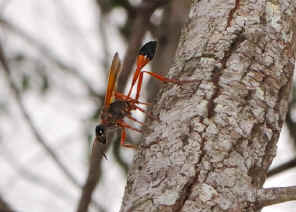- This page contains pictures and information about Mud-Daubers, Thread-waisted Wasps and Digger Wasps
in family Sphecidae hat we found in the Brisbane area, Queensland, Australia.
-
 -
- Species in Sphecidae are solitary hunting wasps. Female wasp makes nest in soil or
build mud cells for her young. She paralyses host arthropod, usually other
insects or spiders, by her sting. The sting is a modified ovipositor
which injects venom paralyses but not kill the host. She keep the hosts in the
nest and lay egg on hosts body. Larva hatches and feeds externally on prey.
Larvae are legless and grub-like.
-
- Wasps in this family are from small to large in size and some species have long slender waist. Adult wasps feed on
nectar or honeydew. All wasps in this family will sting, although most
Australian species are not aggressive. They
usually found hunting on ground or on leaves, or sometimes found dragging prey
to their nest. Nests are different for different species. Some nests are made by
burrowing in the ground, by using existing cavities in ground, in dead wood
or in pith of plants. Some species construct mud cells in open, on
house walls or rocks or tree trunks, some use abandoned mud nests.
-
- We found quite a number of wasps in family Sphecidae and listed in the following
pages;
-
 Sceliphroninae - Mud-dauber Wasps Sceliphroninae - Mud-dauber Wasps
- Wasps in this tribe build mud cell nest and provisioned the young with spiders.
-
-
-
-
-
-
-
-
-
-
-
-
 Ammophylinae
- Thread-waisted Wasps Ammophylinae
- Thread-waisted Wasps- The wasps in Ammophylini
are usually black/red or black/yellow in colours. They build ground burrows and provision with
caterpillars.
-
-
-
-
-
-
-
-
-
-
-
 Sphecinae -
Digger Wasps Sphecinae -
Digger Wasps- Wasps in subfamily are usually black in colour, from medium to large
size. They have the abdomen link with thorax with very slender cylindrical
stalk-like petiole, i.e. the thread-waist. They predatory on Orthoptera.
Females build nest for their young by digging long tunnel in sandy
ground.
-
-
-
-
-
-
-
-
-
- Reference:
- 1. Insects
of Australia, CSIRO, Division of Entomology, Melbourne University
Press, 2nd Edition 1991, pp 989.
- 2. Insects of Australia and New Zealand - R. J. Tillyard, Angus
& Robertson, Ltd, Sydney, 1926, p297.
- 3. Family SPHECIDAE Mud-daubers, Sand
Wasps - Australian Faunal Directory, Australian Biological Resources
Study, 2009.
- 4. What wasp is that? - An interactive identification guide to the Australasian families of Hymenoptera, 2007.
- 5. Sphecidae - Insects of Townsville, Australia - Graeme Cocks.
- 6. Wasps - family Sphecidae - lifeunseen.com, by Nick Monaghan.
- 7. The sand wasps: natural history and behavior
- Howard Ensign Evans, Kevin M. O'Neill, 2007.
- 8. Northern Territory Insects, A Comprehensive Guide CD - Graham Brown, 2009.
- 9. Sphecidae - Australian National Insect Collection Database, CSIRO.
- 10. Family SPHECIDAE (Digger Wasps)
- Insects of Cedar Creek, Ecosystem Science Reserve, 2000.
- 11. Sphecidae {family} - Barcode of Life Database.
[ Up ] [ Nesting Behaviour ] [ Sphecidae ] [ Crabronidae ] [ Unknown Sphecid Wasps ]
|